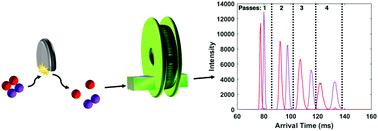Our official English website, www.x-mol.net, welcomes your
feedback! (Note: you will need to create a separate account there.)
Surface-induced dissociation of protein complexes on a cyclic ion mobility spectrometer
Analyst ( IF 3.6 ) Pub Date : 2021-10-11 , DOI: 10.1039/d1an01407b Dalton T Snyder 1 , Benjamin J Jones 1, 2 , Yu-Fu Lin 1, 2 , Dale A Cooper-Shepherd 3 , Darren Hewitt 3 , Jason Wildgoose 3 , Jeffery M Brown 3 , James I Langridge 3 , Vicki H Wysocki 1, 2
Analyst ( IF 3.6 ) Pub Date : 2021-10-11 , DOI: 10.1039/d1an01407b Dalton T Snyder 1 , Benjamin J Jones 1, 2 , Yu-Fu Lin 1, 2 , Dale A Cooper-Shepherd 3 , Darren Hewitt 3 , Jason Wildgoose 3 , Jeffery M Brown 3 , James I Langridge 3 , Vicki H Wysocki 1, 2
Affiliation

|
We describe the implementation of a simple three-electrode surface-induced dissociation (SID) cell on a cyclic ion mobility spectrometer (cIMS) and demonstrate the utility of multipass mobility separations for resolving multiple conformations of protein complexes generated during collision-induced and surface-induced unfolding (CIU & SIU) experiments. In addition to CIU and SIU, SID of protein complexes is readily accomplished within the native instrument software and with no additional external power supplies by entering a single SID collision energy, a simplification in user experience compared to prior implementations. A set of cyclic homomeric protein complexes and a heterohexamer with known CID and SID behavior were analyzed to investigate mass and mobility resolution improvements, the latter of which improved by 20–50% (median: 33%) compared to a linear travelling wave device. Multiple passes of intact complexes, or their SID fragments, increased the mobility resolution by an average of 15% per pass, with the racetrack effect being observed after ∼3 or 4 passes, depending on the drift time spread of the analytes. Even with modest improvements to apparent mobility resolving power, multipass experiments were particularly useful for separating conformations produced from CIU and SIU experiments. We illustrate several examples where either (1) multipass experiments revealed multiple overlapping conformations previously unobserved or obscured due to limited mobility resolution, or (2) CIU or SIU conformations that appeared ‘native’ in a single pass experiment were actually slightly compacted or expanded, with the change only being measurable through multipass experiments. The work conducted here, the first utilization of multipass cyclic ion mobility for CIU, SIU, and SID of protein assemblies and a demonstration of a wholly integrated SIU/SID workflow, paves the way for widespread adoption of SID technology for native mass spectrometry and also improves our understanding of gas-phase protein complex CIU and SIU conformationomes.
中文翻译:

循环离子迁移谱仪上蛋白质复合物的表面诱导解离
我们描述了一个简单的三电极表面诱导解离 (SID) 单元在循环离子迁移谱仪 (cIMS) 上的实现,并展示了多通道迁移分离在解决碰撞诱导和表面产生的蛋白质复合物的多种构象方面的效用。诱导展开(CIU & SIU)实验。除了 CIU 和 SIU 之外,蛋白质复合物的 SID 可以在本机仪器软件中轻松完成,无需额外的外部电源,只需输入单个 SID 碰撞能量,与之前的实现相比,用户体验得到了简化。分析了一组环状同源蛋白复合物和具有已知 CID 和 SID 行为的异六聚体,以研究质量和迁移率分辨率的改进,后者提高了 20-50%(中位数:33%) 与线性行波装置相比。完整复合物或它们的 SID 碎片多次通过,每次通过平均提高 15% 的迁移率分辨率,在大约 3 或 4 次通过后观察到跑道效应,这取决于分析物的漂移时间扩展。即使表观迁移率分辨能力略有提高,多通道实验对于分离 CIU 和 SIU 实验产生的构象也特别有用。我们举例说明了几个示例,其中 (1) 多通道实验揭示了以前由于流动分辨率有限而无法观察或模糊的多个重叠构象,或 (2) 在单通道实验中出现“原生”的 CIU 或 SIU 构象实际上略微压缩或扩展,变化只能通过多通道实验来测量。
更新日期:2021-10-12
中文翻译:

循环离子迁移谱仪上蛋白质复合物的表面诱导解离
我们描述了一个简单的三电极表面诱导解离 (SID) 单元在循环离子迁移谱仪 (cIMS) 上的实现,并展示了多通道迁移分离在解决碰撞诱导和表面产生的蛋白质复合物的多种构象方面的效用。诱导展开(CIU & SIU)实验。除了 CIU 和 SIU 之外,蛋白质复合物的 SID 可以在本机仪器软件中轻松完成,无需额外的外部电源,只需输入单个 SID 碰撞能量,与之前的实现相比,用户体验得到了简化。分析了一组环状同源蛋白复合物和具有已知 CID 和 SID 行为的异六聚体,以研究质量和迁移率分辨率的改进,后者提高了 20-50%(中位数:33%) 与线性行波装置相比。完整复合物或它们的 SID 碎片多次通过,每次通过平均提高 15% 的迁移率分辨率,在大约 3 或 4 次通过后观察到跑道效应,这取决于分析物的漂移时间扩展。即使表观迁移率分辨能力略有提高,多通道实验对于分离 CIU 和 SIU 实验产生的构象也特别有用。我们举例说明了几个示例,其中 (1) 多通道实验揭示了以前由于流动分辨率有限而无法观察或模糊的多个重叠构象,或 (2) 在单通道实验中出现“原生”的 CIU 或 SIU 构象实际上略微压缩或扩展,变化只能通过多通道实验来测量。









































 京公网安备 11010802027423号
京公网安备 11010802027423号